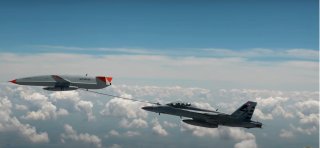The U.S. Navy’s Stealth Fighters Can Refuel from Drones
Though the Navy’s manned-unmanned pairing programs are still in their infancy, the United States is on the cusp of arguably one of the most significant advancements in warfare in the past hundred years.
A recent in-flight refueling test highlighted how far the Navy has come in stealthy manned-unmanned pairings.
The United States Navy’s MQ-25 Stingray tanker drone refueled an F-35C Lightning II, a first for the carrier-based drone. Although the flight did not occur off of a carrier flattop, it was an important validation of the Stingray’s interoperability with the United States’ premiere stealth fighter.
“During the three-hour flight, a Navy F-35C pilot from Air Test Wing and Evaluation Squadron Two Three (VX-23) approached T1, performed formation evaluations, wake surveys, drogue tracking and plugged with the MQ-25 test asset at 225 knots calibrated airspeed (KCAS) and altitude of 10,000 feet,” the Navy’s statement on the event said. “From the ground control station, an air vehicle operator then initiated the fuel transfer from T1’s aerial refueling store to the F-35C.” The event was the third time the Stingray had conducted an in-flight refuel.
As the MQ-25 Stingray has already refueled other Navy aircraft via its relatively simple probe-and-drogue refueling system, this test was more for evaluating how the F-35C interacted with the MQ-25 Singray’s wake rather than evaluating the feasibility of the Stingray’s refueling system.
Into the Future
The MQ-25 is the United States Navy’s first unmanned carrier-capable tanker, and as such, will fill a critical role for the sailing service by extending the combat ranges of all carrier aircraft, including stealthy 5th-generation fighters like the F-35C and F-35B as well as the Navy’s 4th generation fighters like the F/A-18 Super Hornet.
More importantly, however, unmanned inflight tanking is one of the United States’ early mixed manned-unmanned initiatives integrating semi-autonomous or remote-controlled platforms with manned fighters.
One of the more notable programs of record in this area is the Air Force’s Skyborg program, which would pair armed and “smart” or autonomous unpiloted drones with 5th generation fighters, acting as pilots' eyes and ears in contested environments. Though a human pilot would remain in the loop, Skyborg Drones would be able to assess threats in the air and on the ground and decide how to best deal with these threats.
Postscript
“Every T1 flight with another Type/Model/Series aircraft gets us one step closer to rapidly delivering a fully mission-capable MQ-25 to the fleet,” a Navy’s program manager explained. “Stingray’s unmatched refueling capability is going to increase the Navy’s power projection and provide operational flexibility to the carrier strike group commanders.” Though the Navy’s manned-unmanned pairing programs are still in their infancy, the United States is on the cusp of arguably one of the most significant advancements in warfare in the past hundred years.
Caleb Larson is a multimedia journalist and Defense Writer with The National Interest. He lives in Berlin and covers the intersection of conflict, security, and technology, focusing on American foreign policy, European security, and German society.
Image: YouTube

